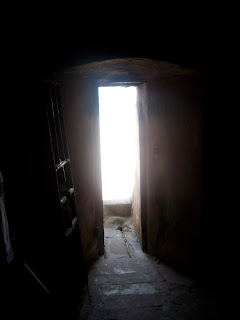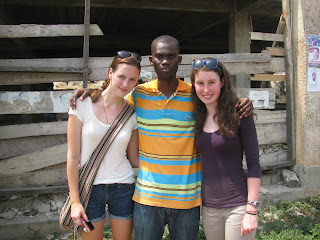Sunday, February 27, 2011
Cape Town, South Africa
Table Mountain overlooks the city of Cape Town and is often covered in low clouds.
Haley, Amelia, and Me after we hiked to the top of Lion's Head Mountain at sunset.
The bay opposite Cape Town. The thick cloud that comes off of Table Mountain is called The Tablecloth by South Africans.
A beautiful sunset over the harbor.
Cape Town at night, from the top of Lion's Head.
Friday, February 25, 2011
Robben Island
A Cell in a block of the prison on Robben Island. Over 50 people lived in this cell for years at a time while imprisoned for opposing the Apartheid.
The inside of Nelson Mandela's cell. He was given only a mat, a blanket, a bowl, a cup and a bucket for a toilet. Nelson Mandela wasn't released until 1990.The limestone quarry on Robben Island in which the political prisoners were forced to labor for hours in hot sun. The pile of stones in the foreground is a memorial to the prisoners there created by former inmates.
South Africa- Townships, The Apartheid, and Robben Island
After we arrived in South Africa I had the opportunity to visit a township. Townships are poor, under-developed neighborhoods surrounding the city of Cape Town. When Blacks were forced out of their homes during the white supremacy government they formed shanty towns on the edge of the city and these were the beginnings of townships. We had lunch there at a local restaurant, the food was delicious! I also got to take a ferry out to Robben Island and visit the prison there. In South Africa's recent history, there was still a very harsh form of segregation. The South African government until recently was white and worked to give white citizens privileges and opportunities while other races were repressed. Of course the issue was not entirely clean-cut. Many white South Africans helped in the struggle to free the black citizens. However, many of the leaders and members of the resistance groups were arrested and imprisoned. Many of these people who were arrested were imprisoned on Robben Island. Our guide who showed us around the prison had been imprisoned there for seven years for being involved in the ANC, the African National Congress. The ANC is now the ruling party in South Africa and the current president of the country was in prison on Robben Island. Probably the most famous inmate of the island was Nelson Mandela who was the first president after Apartheid ended in 1991. Nelson Mandela remains to this day one of the most important figures in the struggle against segregation and racism as well as a powerful advocate for a sustainable Africa. Although South Africa is no longer officially segregated and is the self-proclaimed Rainbow Nation it still faces many issues of racism and colonial legacy to this day.
Slave Castles
Ghana - Slave Castles
While in Ghana I visited two of the slave castles along the coast. I visited the Cape Coast Castle and the Elmina Castle. Ghana was under the power of several European nations before they achieved their independence in 1957. The Portuguese were the first, followed by the Dutch and then the British. These countries used the coast of Ghana as a holding place for slaves before they were shipped across the Atlantic Ocean on the Middle Passage. The Portuguese started this trend and the Dutch followed, however by the time the British controlled Ghana the slave trade was abolished. The castles that I visited had dark holding cells that were crowded and disease ridden. Hundreds of slaves were kept in these slave dungeons for months at a time before being packed into ships that were just as crowded and unsanitary. Each of these castles had a low dark passage out from the dungeons into a door called the Door of No Return. This door was where the slaves would be transferred into slave ships, never to return to their homeland again. In Cape Coast Castle this door was enormous and wooden and led out to the docks that are still used by local fishermen. Elmina Castle's Door of No Return was made from stone and tiny - I don't think I would have fit through it- and it led straight to the water. The door was so narrow because no matter how big a slave was when they entered the dungeons, they could all fit through the door by the time they were sold. These castles are important historical landmarks and have been declared World Heritage Sites. President Obama even visited Cape Coast Castle last year with First Lady Michelle Obama. Slavery was a huge part of the world economy at one time and many African nations, including Ghana are still trying to recover from and come to terms with its effects.
Sunday, February 13, 2011
Pictures from Winneba
SAS students with the chief of Winneba and his party.
Beans in the local market in Winneba.
A Lizard we found while walking around the town.
Beans in the local market in Winneba.
A Lizard we found while walking around the town.
Saturday, February 12, 2011
Haley, Albert, and I
While we were in Winneba a Physics student named Albert showed my friend Haley and me around the local marketplace. He showed us the local foods, fishes and other items for sale such as beautiful textiles.
Ghana - Winneba
The first day we arrived in Ghana I travelled to the city of Winneba with my friend Haley, about 50 other students and several SAS faculty. Winneba is about 3 hours away from Takoradi, the city where we were docked. When we arrived we were greeted by the political and cultural leaders of the city. Ghana is set up on a parliamentary system in which there are ministers and other officials to oversee individual areas of land. However, traditional chiefs also still hold a lot of power. There is an entirely separate governing system in each town or city made up of traditional leaders and elders who hold an enormous amount of cultural and political power. After being welcomed by both bodies we had a delicious dinner of chicken, rice and plantains. That evening we were invited to visit one of the campuses of the University of Education, based in Winneba. We were welcomed by several members of the faculty and student government at the university along with other Ghanaian students who had come. We received several speeches and musical performances. After the official welcome we were able to talk to the students before we left. Everyone was so friendly and hospitable, it was amazing. The next morning we visited the music department at the University of Education. A large part of Ghanaian culture focuses around formal ceremonies of welcome in order to extend their hospitality to guests so we listened to several more speeches welcoming us and telling how happy the faculty and students were to have us here. We then were lucky enough to have several student performances. We were also invited to dance and the students were more than happy to show us the steps. The dance was called a high life, which my partner, Festus, explained to me was a popular Ghanaian dance based on more traditional dances but had been changed to suit the more modern times. We were able to talk to the music students and I met one student called Sarfo who was involved in student government and hoped one day to come to America. I also met a student named Kenneth, who played the violin (like me) so we were able to talk about playing. He told me that as part of his training he had to learn to completely take apart his instrument and reassemble it because classical instruments were so rare in Ghana. Before leaving Winneba we were also visited by the minister representing Winneba in the Ghanaian parliament. He told us about politics, land use and health care in Ghana. The government is pushing for sustainability in both rural and urban Ghana but oil is also a big factor and often wins out over more environmental concerns. The government also wants to encourage business and foreign investment. Health care is a new issue in Ghana. A new program was recently implemented that provides free or reduced health care for certain people who qualify. The elderly, disabled, disadvantaged or abandoned qualify to receive health care while others still have to pay. There are many technologically advanced hospitals in Ghana but sanitation is still a problem and most rural communities don't have basic coverage or clinics. The majority of Ghanaians use natural medicine in conjunction with drugs and modern doctors. To be continued...
Saturday, February 5, 2011
Caymen Hunter...
We went caymen spotting on the Rio Negro at night and I got to hold a young caymen before we released it back into the river.
Tuesday, February 1, 2011
Subscribe to:
Comments (Atom)


















